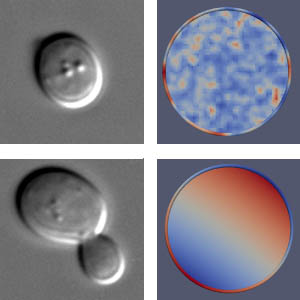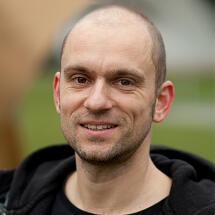Prof. Dr. Christian Engwer
Numerical Simulations to understand Cell motility

Computer Sciences /Mathematics / Math. Modeling / Image Analysis / Numerical Simulations / High Performance Computing
Migration of cells is commonly described as a process of alternating protrusion and retraction. This process is believed to be maily driven by actin polymerization and depolymerization. At the protruding front actin polymerizes and stiff actin filaments directly push the membrane forward, while at the retracting rear actin filaments are depolymerized. This process is assisted by contractile proteins at the rear end, pulling the rear in. Forces are transferred to the surrounding domain via adhesive receptors. In addition to the actin polymerization and the involved system biological processes, experiments show that ion channels and transporters play an important role in cell migration.
Modern simulation tools allow to directly simulate the mechanical behaviour of a single cell. The elastic behaviour of the membrane and the fluid of the cell body are described by fundamental physical laws and modelled using partial differential equations.
Experimental data suggest that intra cellular flow is evoked by osmotic gradients, which are maintained by ion channels. Using direct simulation we will investigate the intra cellular flow and how it is influenced by local ion channels.

Vita
- 1997 - 2003: Diplom : University of Heidelberg, Subjects: Physics, Computer Science
- 2004 - 2009: Promotion: University of Heidelberg, University of Stuttgart, Subject: Mathematics
- 2009 - 2011: Post-Doc: University of Heidelberg
- Since 2011: J-Prof. University of Münster
Selected references
C. Engwer and S. Westerheide. Heterogenous coupling for implicitly described domains. Lecture Notes In 'Domain Decomposition Methods in Science and Engineering XXI', to appear.
P. Bastian and C. Engwer (2009). An unfitted finite element method using discontinuous Galerkin.International Journal for Numerical Methods in Engineering, 79(12):1557–1576.
P. Bastian, M. Blatt, A. Dedner, C. Engwer, R. Klöfkorn , R. Kornhuber, M. Ohlberger, and O. Sander (2008). A generic grid interface for parallel and adaptive scientific computing. Part II:Implementation and tests in DUNE. Computing, 82(2–3):121–138, 7.
P. Bastian, M. Blatt, A. Dedner, C. Engwer, R. Klöfkorn , M. Ohlberger, and O. Sander (2008). A generic grid interface for parallel and adaptive scientific computing. Part I: Abstract framework. Computing, 82(2–3):103–119, 7.
P. Bastian, A. Chavarría-Krauser, C. Engwer, W. Jäger, S. Marnach, M. Ptashnyk (2008). Modelling in vitro growth of dense root networks. Journal of Theoretical Biology, 254(1): 99–109.
Links
